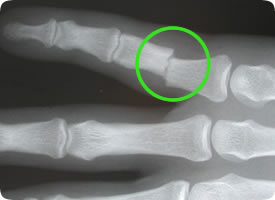Finger Fracture (Broken finger)
Symptoms
I treat hundreds of finger fractures (broken fingers) each year. Finger fractures commonly occur as the result of catching the finger awkwardly and are common sports injuries.
There are 3 bones in each finger and 2 in the thumb, these are called phalanges. Fractures fall into several categories: those involving the middle part of the bone (shaft), fractures involving the joint and 'avulsion' fractures where a small piece of bone is pulled off when a ligament around a joint has been damaged.
Diagnosis
 The diagnosis of a finger fracture and decision of how to treat it is usually made with good quality X rays in addition to a
thorough examination of the finger. In some cases a scan is required.
The diagnosis of a finger fracture and decision of how to treat it is usually made with good quality X rays in addition to a
thorough examination of the finger. In some cases a scan is required.
Treatment
The best treatment for a broken finger depends on which bone / part of the bone is involved, whether it is in an acceptable position and how stable the fracture is. Most finger fractures do not require surgery and are treated with custom made plastic splints and hand therapy (specialised physiotherapy). It is very important with injured fingers to prevent the small joints from becoming stiff (this can occur quite quickly).
Surgery
If a fracture is in a poor position (angulated, rotated or out of alignment) or is unstable (ie it is difficult to hold the bone in the best position) surgery may be required. The surgical procedure used will be the least invasive technique to achieve the desired result. In straightforward cases it is possible to manipulate or pull the fracture into a good position that is stable. If the fracture is not stable once it has been reduced, it may be necessary to hold it in position using one or more 'K wires', thin, stiff wires that are drilled into the bone. These are left in place for 3-4 weeks while the bone starts to heal. Fractures can also be treated by a technique known as ORIF (open reduction and internal fixation) in which small screws or metal plates are used to put the bone precisely back together. I have extensive experience with this type of surgery that must be done very carefully, minimising the amount of 'cutting' that is done.
Keyhole Surgery
To improve the results of finger fractures when surgical treatment is necessary, I have developed a minimal access 'keyhole' technique. This technique uses a very small incision through which screws are inserted to 'fix' the fracture. This technique has been presented at a National surgery meeting and other surgeons are now starting to use my method. The advantages of the minimal access technique for fixation of finger fractures are: a very small scar (approximately 1cm), quick recovery time and excellent movement. The technique is not suitable for all finger fractures.
After Surgery
Finger fractures take 3-4 weeks to start healing and 6-8 weeks to be strongly healed. A splint will be required to protect the finger, usually for 4-6 weeks. Hand therapy is a very important part of the post-operative programme. Hand therapy involves a tailored programme of exercises, physical therapy such as stretching, and sometimes other treatments, for example ultrasound. You will have exercises to do at home.


